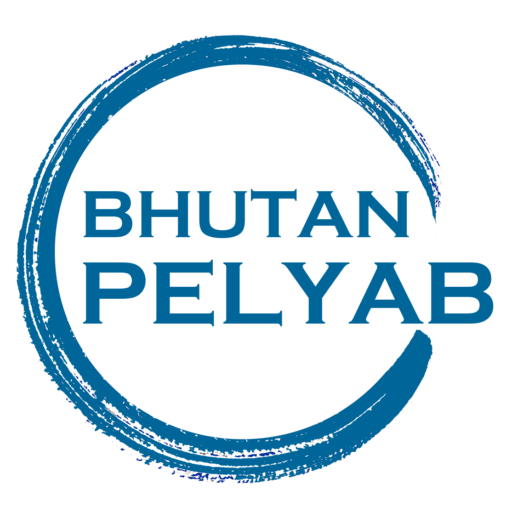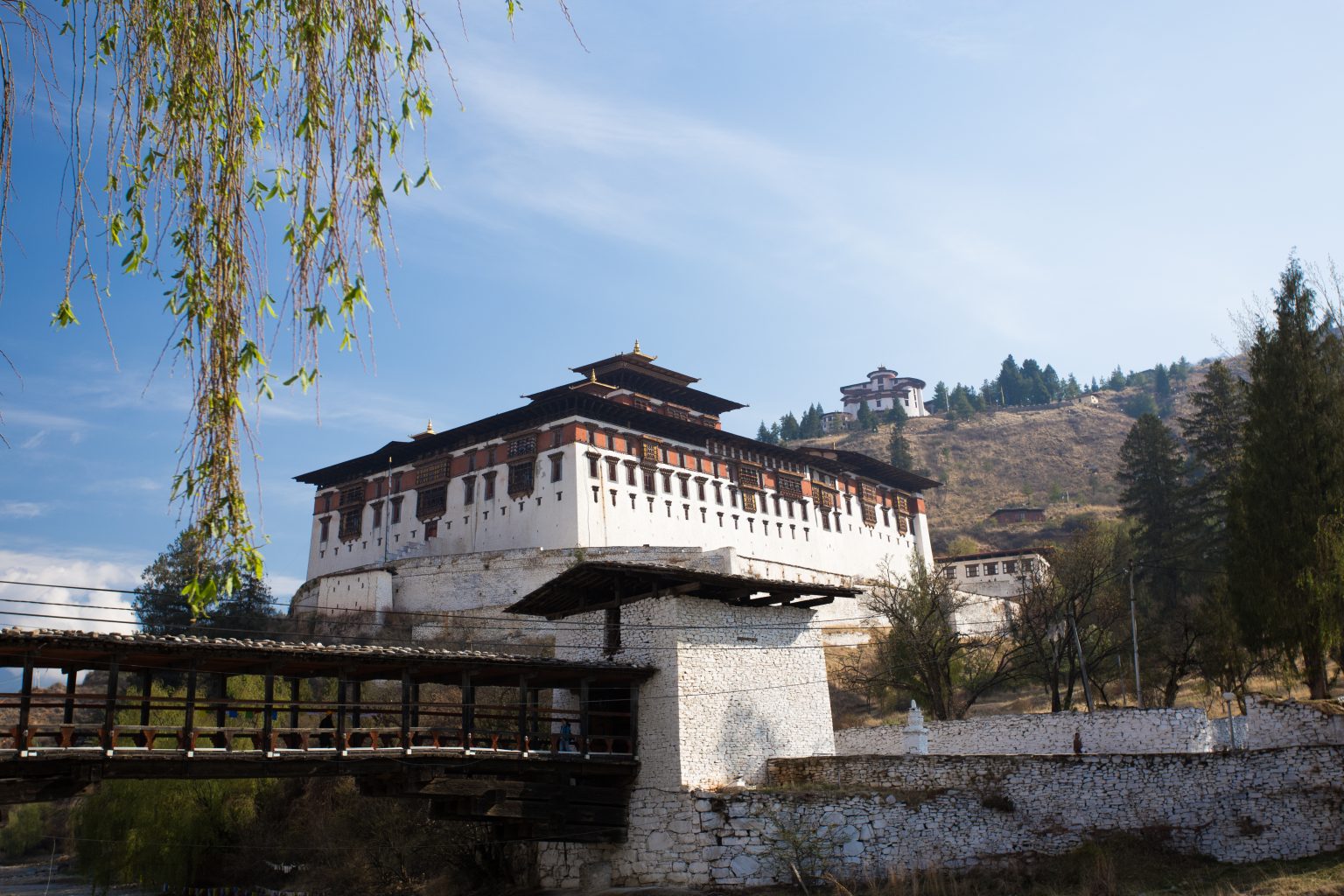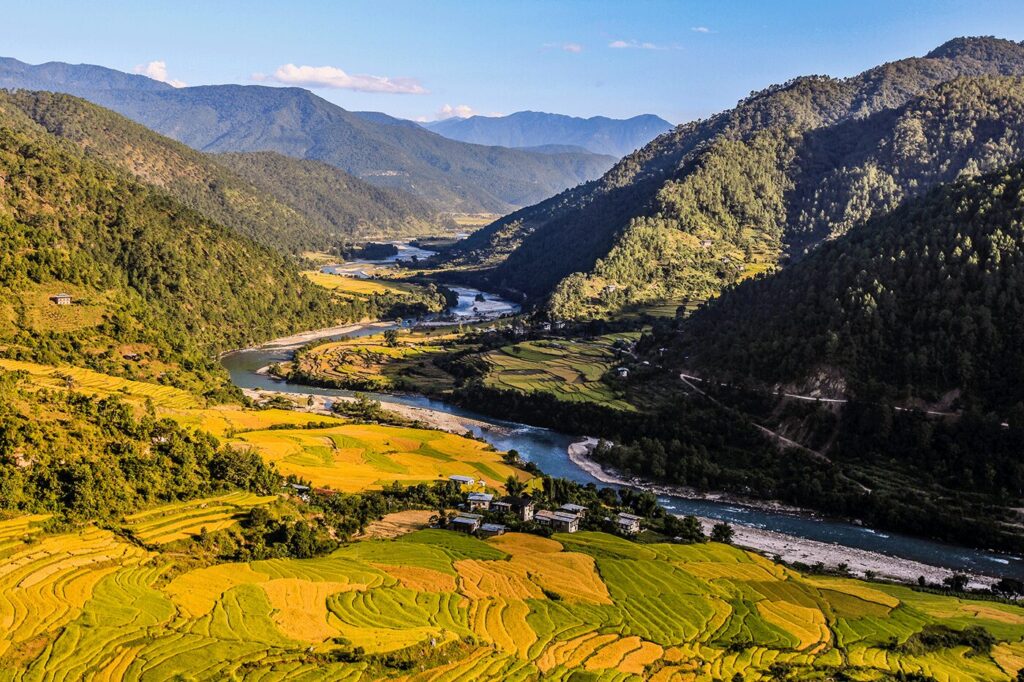Day 01: Arrive in Paro and transfer to Thimphu
- Altitude in Paro: 2,300m
- Altitude in Thimphu: 2,400m
- Distance: 55km
- Estimated travel time: 1.30hrs
Right before landing in Paro, you can look out from the plane’s window for a grand view of the Himalayan mighty mountains. Meet up with our representative and we will then drive to Thimphu – Bhutan’s capital. While driving to Thimphu, we will stop to visit the eminent Tachogang Lhakhang (Temple of The Excellent Horse). This striking building was erected by the legendary Bhutanese bridge builder Thangtong Gyalpo (1385-1464).
In Thimphu, we will first head to the National Memorial Chorten, built following the idea of Bhutan’s Third King, His Majesty Jigme Dorji Wangchuk. The renowned site was dedicated for world peace and prosperity, and later became a memorial to the Third King.
The next destination is Buddha Point (Buddha Dordenma Statue), a massive statue at a height of 51.5m. It is one of the largest Buddha statues in the world. Standing on top of a hill, the grand statue overlooks the whole valley and emanates an aura of peace and happiness to the world. There are 125,000 smaller Buddha statues housed inside the giant site.
From there, we will visit Tashichho Dzong (Fortress of The Glorious Religion). First built in 1216 A.D, the famous complex was completely renovated by King Jigme Dorji Wangchuck after he moved the capital to Thimphu in 1952. Since then, it has served as the seat of the government. The impressively large construction is surrounded by well-kept lawns and exquisite gardens. This destination is also visitor’s favorite for the enchanting ceremony of flag changing at 5pm. The rite begins in the courtyard and ends outside in the front of the dzong.
Afterwards, we will come back to central Thimphu and stay overnight at the hotel there.
Day 02: Thimphu to Gangtey
- Altitude in Gangtey: 2,900m
- Distance: 160km
- Estimated travel time: 6hrs
Leaving the capital, we will travel to Gangtey valley (or ‘Phobjikha valley’). On the road to Gangtey, we will first stop at Dochula pass. Located at 3,050m, this is a famous sightsee place for visitors to Bhutan, from here you can get the panoramic view of the eastern Himalayan ranges. On clear days, the scene is the most astonishing with the picture of 108 sacred chortens and the mighty snow-clad peaks behind the veil of thick mists. It is probably one of the most wonderful places to capture the beauty of Bhutan.
The first landmark we will visit in Gangtey is Gangtey Goemba or ‘Gangtey monastery’. The building was built in 1613 and it overlooks the entire valley from the top of a forested hill. The whole construction consists of the central goemba, monks’ quarters, a small guesthouse and outlying meditation centres. Gangtey valley is the winter home of the rare Black Necked Cranes, you can catch the sight of the rare birds from November to March.
You will stay overnight at the hotel in Gangtey.
Day 03: Gangtey to Bumthang
- Altitude in Bumthang: 2,800m
- Distance: 158km
- Estimated travel time: 6hrs
Today, we will start the trip with the famous Gangtey Nature Trail, which will allow us to explore the wonderful Phobjikha valley. The popular trail will start from the small hilltop overlooking Gangtey Goemba and descend to beautiful flower meadows then to Semchubara village. We will pass through verdant blue pine forest before hiking down towards a valley viewpoint. The trail will end once we reach Khewang Lhakhang (Khewang temple). We will also visit the Black Necked Cranes Visitor Centre, where we can get more information about the bird species.
Later, we will drive to Bumthang – the Spritual Heartland of Bhutan. The region is home to some of the oldest palaces, Buddhist temples and monasteries of the kingdom.
We will continue the trip with a visit to Yathra Weaving Center, a very well-known weaving center in Chumey valley, Bumthang. You will witness the local ladies weaving yathras – the region’s special woven textile with intricate patterns. This unique weaving art has been passed down from generation to generation in Chumey.
Because of the long drive, we will stop at certain places for tea/refreshments and later spend the night at the hotel in Bumthang.
Day 04: Bumthang sightseeing
Jambay Lhakhang, our first destination to explore in Bumthang, belongs to the 108 sacred temples built by the Tibetan King Songsten Gampo in the 7th century. Legends said that the series of temples was to pin down a demoness, who wished to prevent the introduction of Buddhism to Tibet. The renowned temple is believed to pin her left knee. Later, the sacred building was visited by Guru Rinpoche when he was in Bumthang. It is a place in the valley that feels truly ancient.
Next, we will travel to Kurjey Lhakhang, a massive and important temple complex. The construction was named after the body (kur) print (jey) of Guru Rinpoche, which is preserved in a cave inside the oldest of the complex’s three buildings. The first temple, also the most sacred one, was erected in 1652 and is where the body print of Guru Rinpoche is protected. The second one was constructed by Ugyen Wangchuck, the first king of Bhutan, and the third temple was established by Ashi Kesang Wangchuck, queen to the third king, in 1984.
We will also visit Kurjey Drupchu, next to the Kurjey temple, to see the holy water, which is believed to have been blessed by Guru Rinpoche.
After that, we will visit Tamshing monastery, formally called Tamshing Lhendup Chholing (Temple of the Good Message). Established in 1501 by Pema Lingpa, it is the most important Nyingma goemba in Bhutan. If you prefer, we can walk from Kurjey Lhakhang to this site, which will only take 1 hour.
We will have a lunchbreak and then go to Lhodrak Kharchu Monastery. The renowned monastery was blessed by Guru Rinpoche and is the seat of the successive Namkhai Nyingpo reincarnates. There are about 400 monks in residence here.
Afterwards, we will follow the path downhill to get back to the town, the walk will be approximately 20 mins. We will spend another night at the hotel in Bumthang.
Day 05: Discover Bumthang
In the morning, we will travel to Mebar Tsho – the Flaming Lake, one of the holiest sites in the region. Located at the lower end of Tang valley, the sacred lake is related to the renowned religious treasurer Terton Pema Lingpa. He was the one who discovered treasure, hidden within the lake by Guru Rimpoche, in the late 15th century. Today, the fresh water lake is a sacred pilgrimage site for the locals with multicoloured prayer flags surrounding it. It is said that people with spiritual minds can distinguish an extraordinary sight when looking down into the lake.
As we reach Tang valley, we will head to the village and hike to the Tang Ogyen Choling Palace And Museum. The structure was one of the 8 lings (places) established by Longchen Rabjam (1308-1363), and later chosen by Terton Dorji Lingpa as one of his centres. Because of its link with two great Tibetan masters, the site is of considerable importance for Bhutan as well as for the Tibetan Buddhist world. Then we will hike back to the village, which will take roughly 1.5 hour.
Overnight at the hotel in Bumthang
Day 06: Bumthang to Trongsa
- Altitude in Trongsa: 2,216m
- Distance: 80km
- Estimated travel time: 3hrs
From Bumthang, we will drive to Trongsa. Situated on a steep ridge, the town provides splendid views of the surrounding deep valleys but remains separated from both east and west by high mountain ranges.
On arrival in Trongsa, we will first explore Trongsa Dzong – the most famous structure and is easily visible from anywhere in the town. Established in 1644, the imposing dzong sits on a steep ridge high above the roaring Mangde Chhu. The complex’s buildings are connected by a succession of alley-like corridors and impressive paved courtyards, trailing down the ridge. It used to serve as the seat of the Wangchuck dynasty before they became the rulers in Bhutan in 1907.
From there, we will visit Ta Dzong – the former watchtower of Trongsa town. Standing on a promontory above the serene town, the building has 4 observation points, resembling Tiger, Lion, Garuda, and Dragon. It now has been converted into the National Museum of Bhutan, one of the most fascinating museums travelers can find in the country.
Kuenga Rabten is about 23km from the south of Trongsa, which we will arrive after 1 hour of driving. On the way, we will pass below Takse village, a giant waterfall and the fertile rice terraces. The construction was the Second King’s winter palace and will give you a great insight into the early days of Bhutan’s monarchy. There is a gallery running along the courtyard on three sides, and the large main building is on the fourth side as two protruding aisles.
Later, we will hike for 15 minutes or drive uphill from the palace to our next destination, Karma Drubdey Nunnery. First opened in 1968, the place now serves as a monastic school (shedra), retreat center (drupde) and monastic institution (dratshang).
Afterwards, we will return to Trongsa town and spend the night at the hotel there.
Day 07: Trongsa to Punakha
- Altitude in Punakha: 1,300m
- Distance: 150km
- Estimated travel time: 5hrs
Leaving the peaceful Trongsa town, we will travel to Punakha – Bhutan’s former capital. The town has been associated with momentous occasions in Bhutanese history. We will go to explore Punakha Dzong (Palace of Great Happiness). It is the second dzong to be founded in Bhutan, and one of the most majestic constructions in the whole kingdom. The structure is a fine example of Bhutanese architecture, and was the seat of the government until the early 1950s, before Thimphu was chosen as the new capital.
Pho Chhu suspension bridge, which is close to the stunning dzong, is the longest suspension bridge in Bhutan. Gracing along the bridge are the beautiful multicolored prayer flags. When we get to the bridge, you can enjoy the spectacular scene of Punakha Dzong and also the picturesque green expanse of Pho Chhu valley.
We will have lunch before hiking to Khamsum Yuelley Namgyal Chorten. This is a pleasant walk, crossing lovely rice paddies and pine trees on the way. We will get to the famous chorten at an altitude of 1,500m, which stands on an edge above the valley after about 1 hour. The structure is mesmerizing as it is the only one of its kind in the world. The golden-spire chorten and various smaller pagodas surrounding it make fine examples of Bhutan’s architectural and artistic traditions. Looking out from the imposing site, you will be rewarded with the wonderful sight of the entire valley.
Then we will return to the town and stay the night at the hotel in Punakha.
Day 08: Punakha to Paro
- Distance: 125km
- Estimated travel time: 4hrs
We will drive back to Paro today. The town is located in a flat valley bottom and follows a grid-like pattern, and there are many temples and monasteries situated here. On the way, we can enjoy a pleasant walk across hillock fields to Chimi Lhakhang (Temple of Fertility). Childless women will go to the temple to pray and receive a wang (blessing or empowerment). The hike to the beautiful temple will be approximately 25 minutes and pass-through farmlands in Lobesa Village.
We will visit the grand Paro Rinpung Dzong (Fortress of The Heap of Jewels) in the afternoon. This impressive construction is praised as another example of Bhutanese architecture. The stunning fort was built in 1644 on the foundation of a monastery erected by Guru Rinpoche. The site with its huge buttressed walls is visible throughout the entire valley. You can find a stone-paved festival ground, where Paro tsechu is held annually, just outside of the dzong, to the northeast of its entrance.
After that, we will head to the National Museum of Bhutan (or Ta Dzong). This is one of the most attractive landmarks in Paro, where valuable collections regarding to Bhutanese life and culture are displayed. You will see here extensive collections of Bhutan’s thangkas, bronze statues, textiles, weapons and also a hall of stamps.
Tonight we will stay at the hotel in Paro town.
Day 09: Paro sightseeing
One of the most sacred sites in Bhutan, also a destination we cannot miss – Takstsang Monastery (or ‘Tiger’s Nest’) will be the first stop today. Situated on a sheer cliff at an altitude of 3,120m, overlooking pristine forests of oak and rhododendrons. The climb to the holy temple is 4.5km one way, with an elevation gain of around 900m. We will have many stops on the way so that you can sightsee and take photos of the breathtaking valley, with dense forests and might mountains surrounding it.
Next, we will have the chance to explore Kyichu Lhakhang – one of the country’s oldest and most prominent temples. It belongs to the 108 temples constructed by the Tibetan King Songtsen Gampo in the 7th century to mark the introduction of Buddhism across the region. It is also attractive with travelers for the fascinating scene of elderly pilgrims shuffling around the temple and spinning its prayer wheels.
Later, we will have a traditional Bhutanese meal together with a local family in a farmhouse. You will get to know people genuinely, chatting and hearing their stories when enjoying tasty dishes.
We also suggest a traditional hot stone bath at the farmhouse, which is a great way to relax your muscles after a day of hiking. Otherwise, it can be nice to explore the lively pubs in Paro, known for their tasty snacks and local wine.
You will stay in Paro for the last night of the holiday.
Day 10: Depart Paro
After breakfast at the hotel, your guide will accompany you to the airport for flight to your onward destination. Tashi Delek (goodbye and good luck) and we hope to see you again in Bhutan!








